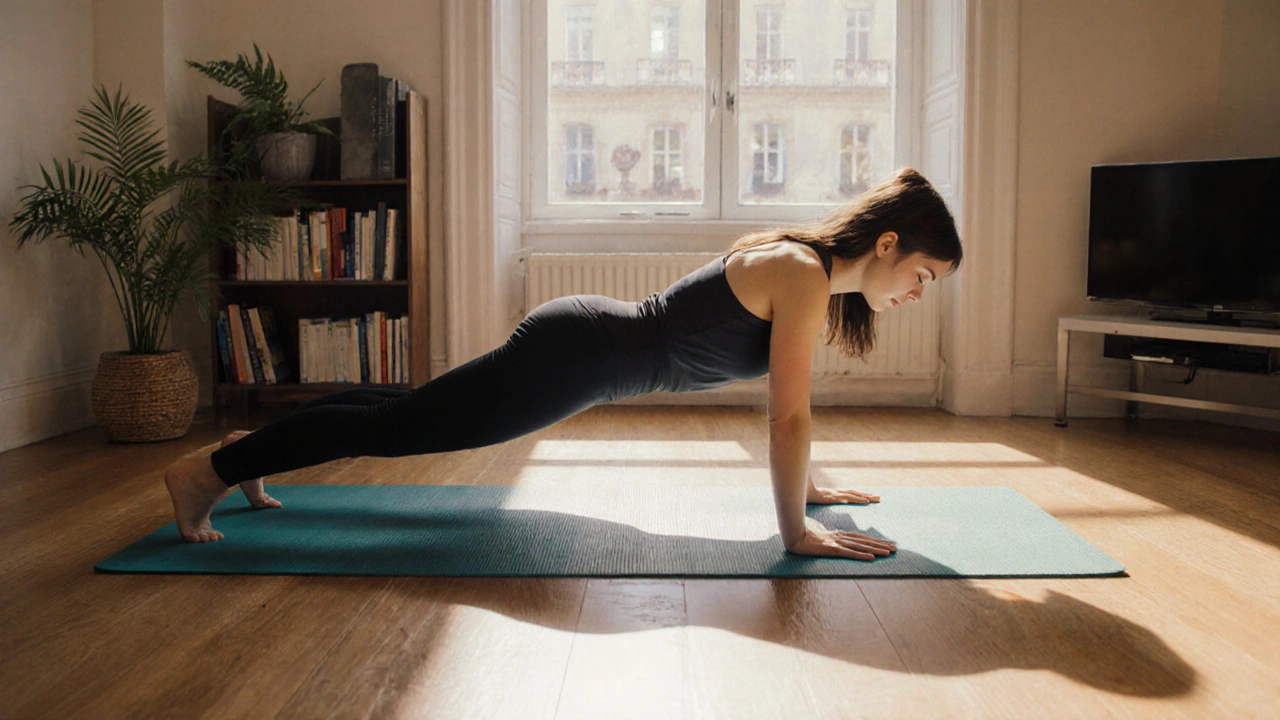When we talk about back health, core strength refers to the combined power of the abdominal, back, and pelvic muscles that stabilize the spine plays a pivotal role. If you’ve ever woken up with a stiff lower back or felt a twinge after a long day at the desk, you’ve already experienced what a weak core can do. Below are the quick takeaways you can start applying today.
Quick Takeaways
- A solid core creates a natural brace for the lumbar spine, reducing strain on discs and ligaments.
- Targeted core exercises improve posture, which in turn lowers the risk of chronic backache.
- Consistency beats intensity - a few minutes a day beats a once‑a‑month marathon session.
- Integrating core work into everyday activities (lifting, sitting, walking) multiplies the benefit.
- When pain persists, a physiotherapy program that includes core activation assessment can pinpoint gaps.
Why Core Strength Matters for the Lower Back
The spine is remarkably flexible, but that flexibility comes with a cost: the vertebrae rely on surrounding muscles to stay aligned. The lumbar spine the lower portion of the spinal column bears most of the body’s weight, especially when we bend, lift, or sit for long periods. Without a sturdy core, the lumbar vertebrae must compensate, leading to micro‑traumas that add up over time.
Think of the core as a corset. When it’s tight, it holds the ribs and pelvic girdle in place, allowing the back muscles to work efficiently. When it’s loose, the “corset” sags, and the lumbar joints start to wobble. That wobble translates into the familiar ache that many call "back pain".
Key Muscles in a Strong Core
Most people associate the core with six‑pack abs, but true core strength is a team effort:
- Abdominal muscles including the rectus abdominis, transverse abdominis, and obliques create compression that protects the spine.
- Deep back muscles like the multifidus and erector spinae provide extension and stability.
- The pelvic floor and diaphragm work together with the abdominals to manage intra‑abdominal pressure.
Neglecting any one of these groups can create an imbalance that shows up as a backache.
Core Exercises That Directly Target Back Pain
Below is a concise comparison of the most evidence‑backed moves. Each exercise focuses on different muscle subsets, difficulty levels, and typical repetition ranges.
| Exercise | Primary Muscles | Difficulty | Suggested Reps/Sets |
|---|---|---|---|
| Plank static hold for full‑body tension | Transverse abdominis, rectus abdominis, shoulders | Beginner → Advanced | 20‑60 seconds, 3 sets |
| Bird‑Dog quadruped limb extension | Multifidus, glutes, shoulder stabilizers | Beginner | 10‑15 reps per side, 3 sets |
| Dead‑Bug supine alternating arm/leg lift | Deep abdominals, hip flexors | Beginner → Intermediate | 12‑20 reps per side, 3 sets |
| Side Plank lateral core stabilization | Obliques, quadratus lumborum | Intermediate | 30‑45 seconds per side, 2‑3 sets |
| Glute Bridge hip thrust from supine | Glutes, hamstrings, lumbar extensors | Beginner | 15‑20 reps, 3 sets |
These moves are low‑impact, require no equipment, and can be performed in a living room or office breakroom. The key is to focus on quality - keep the spine neutral, avoid letting the hips sag, and maintain a steady breath.
Integrating Core Work Into Daily Life
Doing a set of planks before dinner is great, but the real magic happens when you recruit core muscles during routine tasks:
- Standing up from a chair: Engage the abdominals and glutes before pushing off the seat.
- Lifting groceries: Brace the core by taking a deep breath and tightening the belly like you’re about to be punched.
- Driving: Adjust the seat so your hips are slightly higher than your knees; this encourages a neutral spine and forces the core to stay active.
- Typing: Sit tall, shoulders relaxed, and gently pull the belly button toward the spine every few minutes.
These micro‑habits turn core training from a separate workout into a continuous, supportive system.

Common Mistakes That Undermine Core Benefits
- Holding the breath - The Valsalva maneuver spikes intra‑abdominal pressure and can stress the disc. Breathe steadily through each movement.
- Relying on the hip flexors - Over‑active hip flexors take over the job of the deep abdominals, leading to an anterior pelvic tilt.
- Skipping the posterior chain - Ignoring glutes and hamstrings creates a weak “back end,” forcing the lumbar spine to carry extra load.
- Doing endless crunches - Crunches isolate the rectus abdominis but do little for spinal stability.
When to Seek Professional Help
If back pain persists beyond two weeks, intensifies at night, or radiates down the leg, it’s time to consult a health professional. A physiotherapist specialist in movement and musculoskeletal health can assess core activation patterns, identify muscular imbalances, and prescribe a personalized program. In some cases, imaging may be needed to rule out herniated discs or structural issues.
Putting It All Together: A Sample 4‑Week Plan
Below is a simple progression that fits into a 15‑minute daily slot. Adjust the reps if you feel too easy or too hard.
- Week 1: Core activation - 30‑second plank, 10 bird‑dog reps per side, 15 dead‑bug reps per side. Do this every other day.
- Week 2: Add side plank - 20‑second hold each side, increase plank to 45 seconds. Keep bird‑dog and dead‑bug the same.
- Week 3: Introduce glute bridge - 15 reps, 3 sets. Increase plank to 60 seconds, side plank to 30 seconds.
- Week 4: Combine - circuit of plank → bird‑dog → dead‑bug → side plank → glute bridge, repeat twice. Aim for smooth transitions with breath control.
By the end of the month you should notice less stiffness after sitting and a more confident posture when standing.
Bottom Line
Strong core strength isn’t just about looking good in a swimsuit - it’s the backbone (literally) of a pain‑free life. By understanding how the core stabilizes the lumbar spine, choosing the right exercises, and weaving core engagement into everyday motions, you can dramatically lower the odds of chronic backache. Remember, consistency beats intensity, and when pain lingers, a qualified physiotherapist can fine‑tune your program.
Frequently Asked Questions
Can core exercises cure an existing back injury?
Core work can aid recovery by stabilizing the spine and reducing stress on injured tissues, but it should complement- not replace-medical treatment. A physiotherapist can tailor the intensity to avoid aggravating the injury.
How often should I train my core?
Aim for 3‑4 short sessions per week. Even 5‑10 minutes daily, focusing on proper form, is enough to build endurance and protect the back.
Is it safe to do core exercises while pregnant?
Yes, but modify the moves. Replace traditional planks with wall planks and avoid deep crunches. Always check with your obstetrician or a prenatal physiotherapist first.
Do I need equipment for an effective core routine?
No. Bodyweight moves like planks, bird‑dog, and glute bridges are sufficient. If you want variety, a yoga mat or Swiss ball can add comfort but isn’t required.
What’s the difference between core strength and core stability?
Strength is the ability to produce force; stability is the capacity to maintain alignment under load. Both are needed for a healthy back - strength provides the power, stability ensures the spine stays in the right place.

Mike Brindisi
A strong core is the foundation of a pain free back. It binds the rib cage and pelvis together. When the abdominal wall contracts it creates intra abdominal pressure that unloads the spine. The transverse abdominis works like a corset. The multifidus provides segmental stability for each vertebra. If any of these muscles are weak the lumbar discs take on extra shear. Over time that extra shear creates micro tears that turn into chronic ache. Simple movements like a plank can activate the deep abs without straining the neck. Bird dog trains the back extensors while teaching coordination. Dead bug teaches you to keep the spine neutral while the limbs move. Side planks target the obliques and the quadratus lumborum which support lateral bending. Glute bridges bring the posterior chain into the equation and protect the lower back during lifts. Consistency is key you only need five minutes a day. Progress by adding holds or increasing reps as your endurance improves. Remember to breathe keep the breath steady and avoid holding it during the exercises.
Steven Waller
Thinking of the core as a living bridge helps you see why every link matters. The stability it offers is a quiet partnership between posture and breath. By treating each session as a small meditation you build awareness that carries over to daily tasks. Keep the focus on form rather than speed and the back will thank you. Over time this habit becomes a gentle guardian for your spine.
Jay Ram
Just start moving and the pain will start fading.
Elizabeth Nicole
It’s amazing how tiny habit shifts can pile up into real relief. When you stand tall you’re automatically firing those deep stabilizers. Even a brief pause to brace before reaching for a coffee counts. The key is to keep the pattern alive throughout the day. You’ll notice a steadier back and a brighter mood as you go.
Dany Devos
The article presents a thorough overview, yet it overlooks the nuanced role of lumbar facet joints in chronic pain. Ignoring these structures may lead readers to adopt a one‑size‑fits‑all regimen that fails for many. A more detailed discussion of diagnostic imaging would strengthen the argument. Moreover, the suggested progression assumes a baseline fitness that is not universally present. Future revisions should address these limitations to provide a balanced perspective.
Sam Matache
Oh, the drama of a busted back! You think a few planks will save you, but the hidden tension lies in the hips, you know? The silent saboteur is the hip flexor, stealing all the glory. Only when you confront that betrayal will the core truly rise. Until then, it’s just a hollow show.
Hardy D6000
While many chase foreign fitness trends, the truth is that the American military’s training principles have always emphasized functional core work. Those drills were designed for real world load bearing, not for fancy yoga studios. Anyone who claims otherwise is just buying into a global wellness conspiracy. Stick to proven methods rooted in hard‑earned experience. The rest is merely fluff.
Amelia Liani
I hear the frustration behind that bold claim, and I understand the desire for solid, battle‑tested routines. Yet every body is unique, and a compassionate approach can still honor those proven methods. Let’s blend the disciplined drills with gentle progression to avoid injury. By doing so we respect both tradition and individual safety.
shikha chandel
The mainstream core discourse is woefully elementary.
Zach Westfall
Your observation is precise, yet it omits the critical role of diaphragmatic breathing. Proper grammar of the body, as it were, requires that the core and breath move in synchrony. Incorporating breath control elevates the entire routine to a theatrical performance of stability.
Pranesh Kuppusamy
One must consider the hidden agenda behind the promotion of these exercises. The wellness industry, backed by shadow networks, profits from perpetual discomfort. By constantly introducing “new” core protocols they ensure a cycle of dependency. A discerning mind should question who truly benefits from this perpetual loop.
Nicola Gilmour
It’s valuable to keep a critical eye, yet remember that consistency still yields progress. Small, mindful sessions can slowly dismantle the patterns you described. Trust the process and let the subtle gains speak for themselves.
Darci Gonzalez
Absolutely, every step forward matters :) Keep the breathing steady and celebrate each tiny win. Your dedication will transform into lasting strength.
Marcus Edström
From a cultural perspective, integrating core work into daily rituals respects both tradition and modern health. Sharing these practices can bridge communities and foster mutual well‑being. Let’s continue this dialogue with openness.